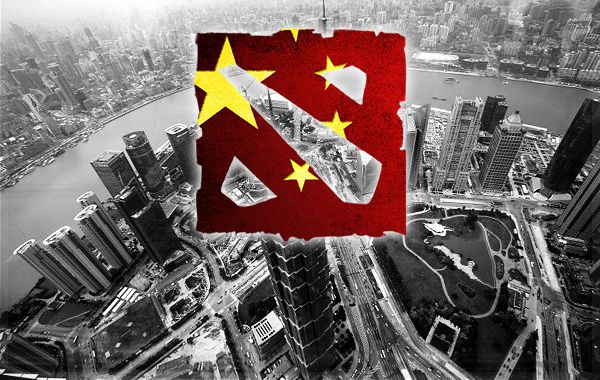Space to Succeed part I: The Infrastructure of New Talent Development

Andy Grove
No different from most long-time fans of professional Dota in the West, my perception of the Dota world was first shattered in ESWC 2010, back during the Dota 1 days, when Ehome, the first of the internationally renowned Chinese teams, went on a rampage in a Western tournament. The sole Chinese invite in a sea of Western teams, Ehome had gone through the tournament without dropping a single game, ending games within 40 minutes during an era when the average Dota game lasted 50-60 minutes. They had stomped the best the West had to offer with trivial ease and in so doing cemented their place in Dota history. What Dota 2 fans had to wait till The International 2 to experience, Dota 1 fans had already gone through in ESWC 2010, and without a Na’Vi to pick up the pieces – though Puppey, Dendi, LightOfHeaven, ArtStyle, and for that matter Loda, were all in the tournament.
In retrospect, the West had it coming. ESWC 2010 was not the first time Asia, and for that matter China, had played and won against the West. Indeed, Zenith and KingSurf of Southeast Asian fame had already made ESWC 2008 an all Asian finals. VP, one of the greatest Western Dota 1 teams of all time, had traveled to China around the same time to practice and scrim with the teams there, with moderate success but for the fact that they kept losing to 7L, the then top team in China, in Chinese tournaments. In December 2009, during the ADL, the Chinese newcomer team XFY had defeated Rox.Kis 3-2 to win one of the first China vs. West tournaments.
But in all of the examples prior to ESWC 2010, there was room for argument. ESWC 2008 was the first time Western teams met Southeast Asian teams and their tri-core farm strategy, the ‘cowardliness’ of which was promptly blamed for the loss. VP posted a losing record only vs. 7L, the best Chinese team. Rox.Kis narrowly lost ADL 2009 to a XFY that they had defeated earlier in the same tournament. None of these tournaments were decisive enough for fans to say – and there was no shortage of fans doing so – that Chinese Dota was way ahead of the West. ESWC 2010, however, had dispelled what argument there was left. For the first time in Dota history, Western Dota had been exposed.
I will never forget an interview conducted shortly before ESWC 2010, which became infamous as an example of Western arrogance and complacency. During the interview, the captain of a top Western team had been asked about Asian teams scouting Western replays in preparation, and whether Western teams were doing the same. His response:
“Sure Asians are scouting. We know that, but we don’t care. We will rape them with our spirit. EU>WORLD.”Ducky
This was the last time Western Dota captains ever spoke lightly of Asian teams, yet it was not the last time arrogance and complacency led to the wholesale defeat of a region’s teams. Fast forward to 2013, the days before the G-1 League in China - the then best team in China and winner of The International 2, IG, was interviewed about the Western invitees. An outspoken member of IG, Chuan, said the following:
“[Regarding Western teams] I can only say that if we don’t completely make fools out of them, then their strategies are decades ahead of ours.”Chuan
Shortly thereafter,Alliance, one of the Western invitees, repeated what Ehome did in 2010 in the homeland of Chinese Dota, before going on to embarrass Chinese teams in The International 3 by making it an all-Western finals. The best Chinese team in TI 3 ended up below the top 3. Chinese Dota had fallen, and so the cycle of complacency had come full circle.
There have ever been those who, in the midst of triumph, in the embrace of success, are tempted into complacency. Indeed, the Dota community is prone to displays of bravado and careless arrogance. Yet, it is precisely the presence of such lapses that prevent the march of progress, and which lead to the stagnancy, decline, and demise of teams and scenes.
It is with this in mind that I request, dear reader, that before you ask why now, ask instead, why not then.Why, before ESWC 2010, was there no one to beat a sense of paranoia into Western teams? Why, before G-1, was there no one to instill paranoia into Chinese teams? For, it is the contentment of success that creates a tolerance for complacency, which in turn sews the fruits of future discontent. As Dota fans, it is our pleasure to watch the best in the world compete, to cheer for our favorite teams, and to experience vicariously the thrill of stupendous victories and devastating defeats. But it is our duty to promote the feeling of paranoia that is necessary for Dota competition to reach the next level. Make no mistake, the professional Dota scene, in the greater scheme of eSports, is but a toddler that has yet to fully walk, much less run.
The “Arteezys of the East”
The rising star of North American Dota, Arteezy boasts a 66% win rate in major LANs
On February 19, 2014, Yao “Maybe” Lu, one of China’s greatest rising stars of Dota, joined the Dota 2 roster of LGD. Hailed the genius of Dota, Maybe had held the top rank on 11, one of the country’s premier Dota 1 platforms. Prior to his debut, Maybe had been hyped in various circles as the “Arteezy of the East” for his mechanical and playmaking skills, especially in the mid lane.
On March 17, 2014, just shy of one month after he was recruited, Maybe left LGD’s main roster and was replaced by long-time veteran Icy of RattleSnakes.cn fame. The decision came out of the left field. Maybe wasn’t doing badly, and his replacement was in no way an upgrade.In their press release, LGD indicated that they paid HGT ~$13,000 to obtain Icy’s services – not a small sum for a player who they soon benched in yet another fiasco swap.But to fixate on the travails of LGD misses the bigger picture, for Maybe was not the first “Arteezy of the East” who failed to find success among China’s top clubs.
Indeed, Maybe’s debacle is immediately reminiscent of Tianyu“Cty” Chen, a fellow pub star mid laner who had made an equally hyped debut in late 2012 before crashing and burning. Cty’s downward spiral was a painful reminder that mechanical skill and pub star status do not alone make for a successful professional career. Cty’s failure to fix his biggest weakness – his in-game decision making – ultimately led to him being ousted from a series of teams. In the end, he was left with no choice but to switch to League of Legends. Cty is currently listed as a League of Legends coach for the Chinese team VG.
Cty was, however, only a high profile example of the trials and tribulations facing newcomers in Chinese Dota, for while high-level amateurs have been looking to establish themselves for the last 2.5 years of Chinese Dota, only a tiny few have been successful: VG.Fy, VG.Fenrir, and LGD.Rabbit. Even then, the teams that took them in were not apex teams at the time: LGD finished below top 8 in the International 3, and VG failed in the qualifiers. But for all the criticism LGD and VG have gotten over the years, they remain the only major eSports organizations in China to experiment with new players.
The biggest organizations in Chinese Dota -IG, Newbee, and DK - are comprised strictly of veterans, and have shown that they would rather bring in veteran talents from Southeast Asia than recruit new Chinese talent. The three aforementioned teams are believed to be among the richest in the world, with financial backing from wealthy patrons and first class training facilities. In short, IG, DK, and Newbee have the luxury of choice when it comes to talent, and their opinions have been unanimous: in the last 2.5 years, no players worth their brand have emerged within Chinese Dota.
China’s New Talent Crisis
Chinese managers have been bemoaning the lack of new talent from early 2013. While one obvious factor is Dota 2’s market penetration in China, such an assessment does not speak the whole story. First, China has millions of Dota 1 players, and it is from this group that new Chinese hopefuls are frequently drawn. Indeed, both Maybe and Cty were Dota 1 pubstars before they made the transition to Dota 2 in hopes of going pro, and the same goes for the successful new pros VG.Fy, VG.Fenrir, and LGD.Rabbit. Thus, the supply of talent exists via the continued fandom of Dota 1.
Second, the demand for Chinese Dota 2 pros is in no way commiserate with the size of the Dota 2 amateur scene in China. Dota 2 is booming internationally, and for the last two years, international organizers have been tripping over each to invite Chinese teams, who provide the perfect Eastern rival for established Western teams. Fans of Chinese Dota are in no short supply, as shown by MLG’s decision to invite DK to their inaugural Dota 2 event. Even within China, the amount of tournaments held for Dota 2 vastly exceeds what ought to exist given the size of the Chinese Dota 2 player base, and there is great passion within the community to keep Chinese Dota alive.
Consequently, both the supply and the demand are there, and in the last two years, we’ve seen a plethora of pro hopefuls, including Tongfu.Wanzhou, CIS, Orenda, Rising Stars, Speed.cn, ex-HGT, and dozens of other, less heard of amateur level teams join the qualifier stages of Chinese tournaments. While that is quantitatively a pittance when put besides the 2,000+ Western amateur teams that signed up for JoinDota League, the average level of play among the aforementioned Chinese hopefuls has been higher. CIS, for example, took games off the best professional team in China, DK, and the bulk of the above teams have shown flashes of brilliance. Certainly, Cty and Maybe were individually top level players, and looked ready for the big leagues.
The prestigious ESL One Frankfurt tournament is one of several to invite Chinese teams this yearDespite initial hype, however, none of these new teams and players was able to secure enduring success, and none have made it into the VIP clubs of Chinese Dota – the sweet spot for sponsorship. Failure to do has caused the disbandment/bankruptcy of not a few teams. A recent example is Rising Stars, which after a brief streak of success in early-mid 2013, promptly ran out of money and sponsors.
Industry observers have not been blind to the situation. GodBlessMali from 2p.com observed China’s new talent crisis in a detailed article analyzing the causes for China’s ignominious defeat in The International 3.According to Mali, top Chinese teams today neglect up-and-coming players, preferring to sign veterans with proven track records. Such attitudes explain why there are no new players in IG, Newbee, and DK, and why VG has dropped two of the five new players they initially signed for veterans.
Mali argued that the tournament format of major Chinese tournaments was also responsible:even when they held qualifiers, Chinese organizers placed amateur/second-tier teams into groups of death too quickly and gave them too few opportunities to practice against top teams and their fellow second-tier teams. Thus, Mali contended, amateur/second-tier teams exited rapidly from tournaments, which then made it difficult for them to practice and become famous, and contrasted this situation with the Western scene, where a plethora of online tournaments with large qualifier stages make it easy for up-and-coming teams to train and make themselves known.
It is correct to say that tournament formats frequently exclude amateur teams, but then again, are they worth being included?Mali, however, fails to consider why Chinese teams and tournament organizers discriminate against newcomers – specifically the cause and effect between the failures of new teams to live up to their hype and their subsequent neglect by organizers.After all, what value was there in showing Team Adidas - now Tongfu.Wanzhou– with their 0-0-16 record?How does a premier league organizer, whose implicit contract with viewers is to provide exciting, high-level matches, reconcile spending money on amateur teams that are practically free wins? While WPC ACE, the official tournament of China’s Dota 2 league, has the wiggle room to include a few amateur teams in hopes that they absorb the experience of playing in a professional league, other organizers are hard pressed to find the same luxury.
The price of failure
“Q: … it is hard for a new team to become a top tier team in Dota 2. What do you think are the reasons? Are you worried about this?”
“A: If everyone has this kind of thought, Chinese Dota 2 will not have any future…”
CIS Manager
Failure, the old adage says, is the road to success. No one has ever become a successful Dota 2 player – and for that matter, a successful anything – without failing. Yet, while failure is necessary to success, it is in no way a great sell. Sponsors, viewers, managers, and organizers all appreciate the fact that a team that fails repeatedly makes for a poor viewing experience, and such sentiments are especially widespread in a scene structured to punish failure – that is to say, in a winners-take-all scene.
The winner of WPC ACE takes over 65% of the total winnings, an overwhelming percentageIt is no news that the Chinese scene loves a winner. The winner of WPC ACE, the premier Dota 2 league in China,receives over 65% of the total tournament winnings. By contrast, getting 4th place in the tournament netted you just 3% of the prize money, and it didn’t matter that you barely lost your matches. In such an environment, it is no wonder that teams are not willing to risk failure and to experiment.
Of course, prize money isn’t all there is.Players are, after all, paid salaries by their teams, and their living expenses while playing in WPC ACE are taken care of. For those of us who work for a living, receiving money to play videos looks to be an awesome proposition. Yet, the superficial benefits of being a pro-gamer disguise the deeper tragedy – which is that the demographic group involved in pro-gaming consists of youths ~16-27 years old. For these players, it is their best years that they are spending for a shot at glory, and the price of failure is a dead-end career, for no one is going to pay a 30+ year old to play video games, while the coaching, managing, and casting jobs are only enough to cover the successful retirees.
On top of limited career advancements, the pay itself is dismal. According to a recent study, the 3,000 full-time eSports players in China earns an average ~$245/month – which includes not just salary, but combined earnings from sponsorship and tournaments. Even by Chinese standards, that is less than 50% of the national wage. The article goes on to say that the cause for this sorry state of affairs is that 90+% of the investment for eSport events in China are concentrated in the top 3% tournaments – i.e the premier leagues. We’ve already seen above that this rule applies to Dota 2 quite well, and further, that within those top 3% tournaments, the prize money is lopsidedly concentrated in the hands of the winner. Talk about an income gap.
Indeed, the absurd top-heavy concentration of WPC ACE stands in harsh contrast with tournaments from other scenes. While the West has no equivalent to WPC ACE, a three month long league, a neighboring country in Asia, known for producing the best players and teams in a variety of eSports games, does.
Prize money distribution from OGN’s Champions league, known for producing the best League of Legends teams in the world, shows a different scheme from WPC ACESeen above, while the total prize pool for OGN’s Champions league is equivalent to that of WPC ACE, the winner of OGN Champions receives less than 30% of the total prize pool, with the rest being distributed smoothly across the sixteen teams in attendance.
Lean though the pyramid of earnings is in Chinese Dota 2, the climb up is steeper still. The path to the top is, ultimately, a path through tournament results. Results lead to fame, glory, fans, and sponsors. Results separate pros from pubs. Results, however, are the end product of a talent development process, both on the side of the individual and on the side of the scene. It is up to the scene to provide the environment and the opportunities; it is up to the player to grasp them.
In the Chinese Dota 2 scene, results are measured by performance in a handful of premier tournaments: WPC ACE, G-League, and the Dota 2 Super League, along with a few online tournaments, which vary from year to year. All of these tournaments share the quality that they are completely oblivious to the different conditions facing the top of the Chinese pro scene and those below them. The fact that IG, Newbee, and DK have tremendous resource and experience advantages over CIS and Orenda does not matter to the organizers of Chinese tournaments: they are placed into the same brackets and groups, at times with a seeding advantage given to the top teams. The philosophy of the organizers is simple: sink or swim.
The mansion of Team DKSuch an equal opportunities setup is, on the surface, meritocratic: every team has the same shot at success. Yet, beneath the egalitarian setup is a fundamental inequity: the top of the Chinese scene is an elite group of teams with stable salaries of $1500-2000/month, professional facilities, veteran players, experienced coaches, and plenty of room for failure in the form of annual contracts and high in-group retention rate.
Their opponents, the amateur/second-tier teams, are the opposite. Not only do they lack all the infrastructural amenities available to the DKs and IGs of the scene, but they have no room to fail and to learn from those failures.According to the aforementioned survey of Chinese eSports players, 84% lack a fixed income, 52% players leave eSports within a year, and 85% within three years. Thus, not only are the cards stacked against the amateur/second-tier teams, but when they fail to produce results – as they inevitably do because of the gap in infrastructure and experience - they are quickly pushed out of the scene by financial pressures, making closing the gap difficult.
There are schools of thought that believe innate talent and personal drive are the only criteria necessary for success. What such schools find difficulty explaining, however, are why certain regions outcompete others. Take, for example, the success of Korean eSports, especially in Starcraft and League of Legends, which have prompted countless soul searching articles in the communities of both games. It has gotten so bad, in fact, that both Blizzard and Riot have taken steps to limit Korean entry in international tournaments, to give other regions home teams to cheer for. That has not, however, redressed the imbalance in international results: all three seasons of WCS Worlds, the premier tournament for SC 2, featured all-Korean finals, and in a recent, top 10 list of teams in League of Legends, produced by lolesports.com, 8/10 top teams, including the 1st and 2nd place teams, were Korean. The idea that individual talent and motivation are sufficient for success becomes untenable when analyzing Korean monopoly in those games, lest we believe that South Korea by itself produces a greater quantity of eSports talent than the rest of humanity combined.
Korean teams already monopolize Starcraft and League of Legends; how long before KESPA brings their infrastructure to Dota 2?
South Korea’s infrastructural advantages over other regions in eSports are widely known, but are normally brought up only in inter-regional discussions of Korea vs. the rest of the world. The argument is, however, no less applicable to intra-regional competition. In the same way that the gap in results between Korean eSports and the rest of the world is incapable of being bridged without fundamental changes in regional infrastructure, so the same argument explains why the gap in results between the top of Dota 2 and the teams below them won’t be easily bridged. While Alliance’s rise in the West has been trumpeted as a case of an up and coming team smashing the establishment, such an observation is fundamentally inaccurate, for the forces behind the Alliance organization – thought to be the same forces behind EG - are no less rich and resourceful than other top Western teams.
What affects the entire Dota 2 world, however, doubly affects the Chinese scene because of the concentration of financial resources into a small set of premier tournaments at the expense of second-tier leagues. With fewer opportunities to display results, amateur/second-tier teams are beholden to higher standards in the few tournaments they do play in, and teams that fail to succeed in one tournament normally have to wait months before they are given an opportunity in another. The cost of failure is high for both the team and the players, because the loss of visibility that results from a subpar performance is fatal for sponsors: there’s no way to promote a team that isn’t competing.
No one believes that the best way to train new, professional basketball players is to have them play top NBA teams while in high-school. Why, then, do Chinese organizers believe that the best way to develop new Dota talent is to force them to defeat top tier, veteran teams while they’re still amateurs, lest financial difficulties force them out of the scene?
Michael Jordan
#gameishard, #teamfeeds
The final, incalculable price of China’s winner-takes-all Dota 2 scene is, however, not financial, but psychological and social.To quote a recent interview from Meracle about the time he spent in Rising Stars:
“Most of them [RisingStars Players] already had no motivation to win.”Meracle about Rising Stars
Psychologists call the effects of success and failure on personal motivation feedback, positive and negative, respectively. Both forms of feedback are necessary. But one of the core observations of developmental psychology is that, when it comes to starting out in a career, positive feedback is paramount. A trainee requires a constant supply of positive feedback, without which he/she is liable to lose motivation and mentally give up. In eSports, given the poor returns facing the average career gamer, such encouragement is especially necessary in order to assure pro hopefuls that they are making progress towards their dreams and are not just wasting their time.
Such positive reinforcementsare, however, absent in the Chinese scene. By constantly placing amateur/second-tier teams against opponents that are greatly beyond their ability in both experience and infrastructure, Chinese organizers are setting them up for failure, discouragement, and ultimately, disbandment. Such failure, in turn, affects the reputation of the new talent, and prevents the inflow of these players into first-tier teams, thereby depriving them of the guidance and encouragement of coaches and veterans, which are only available in those teams.
Further, as new players are setup to fail, a stigma against them is created among veterans who, cut off from the amateurs by generational and environmental differences, increasingly form their own exclusive cliques – old boys’ clubs. While there is no evidence that the old boys’ clubs in Chinese Dota actively discriminate against new talent, there is plenty of talk about specific veterans not wanting to play with new players. Such biases inform the recruitment decisions of top-tier teams, which in China continue to be guided by recommendations, and contribute to the lack of trust and patience they have towards new players. Indeed, though LGD has never given an official cause for Maybe’s relegation, one argument is that he, a young pub star with no prior professional experience, simply did not fit in, socially, with LGD’s four veterans. That explains why Maybe was told to handpick his own, newcomers’ team for LGD.CDEC.
The winner of The International 3, Alliance struck a perfect balance between experienced veterans and new talentSuch disconnects between new and veteran players, however, lead to one of the worst outcomes for a scene. Young, mechanically gifted players, critical to a scene’s continued success, are in dire need of the guidance of veterans and the experience they’ve collected over the years. In fact, the latter constitutes a scene’s greatest asset: its knowledge currency.
The ability to transfer such knowledgeand expertise is what decides whether a scene continues to be successful when its veterans are too old and too slow to compete. It is also, importantly, what dictates whether its next generation surpasses the previous. For only by not starting each new generation tabula rasa are scenes capable of raising their overall skill level, of making progress. Had humanity needed to reinvent the wheel each new generation, we’d never have gotten past the Stone Age.
It is precisely in this task of knowledge transfer that China is greatly behind other scenes. A brief examination of the top teams in China vis-à-vis the top teams in the West illustrates the situation: as of this writing, the 4 top teams in China – DK, IG, VG, and Newbee – boasts a grand total of one team that is a mix of veterans and new talent – the 2nd/3rd placing team, VG. By contrast, of the 4 top teams in the West – Na’Vi, Alliance, EG, and Empire – three out of the four teams are a mix of veterans and new talent.Indeed, one is hard pressed to find a Western team outside of Na’Vi that does not employ new professional players - the next generation of Western Dota 2.
Old man Fear, the most resilient member of EG - he has has been a professional player since the time of CRT screensIn China, however, we continue to see a roster gap in which the top teams’ veterans are segregated from the next generation of players. While amateur/second-tier teams in China boast a host of new talent, with a few exceptions, they have no top tier veteran to guide them. Instead, the top tier talents in China are shuffled back and forth in veteran-only teams – ie IG, DK, and Newbee as they compete to be the winner of the winner-takes-all scheme.From time to time, a few of them retire – a recent example being Zhou– only to be replaced by less skilled but equally veteran players, because from the view of the top teams, only they possess the requisite knowledge to be pros.
The effect of this behavior by China’s top teams manifests itself in play: amateur/second-tier teams in China are commended for their early game laning abilities, but fall flat during the draft and the mid-late game, which is when they lose, time and time again, to veteran teams. Yet, despite the fact that it is these veteran teams’ failure to transfer their knowledge and expertise to the amateur/second-tier teams that is responsible for the latter’s underperformance, that same underperformance is then used to validate the top teams’ decision to not recruit new talent. A vicious cycle is created in which the amateur/second-tier teams’ advancement as a team is denied due to their weaker infrastructure and lack of experience, while their advancement as individual players is prevented due to their failures to post results as a team.
Of course, it is not the job of professional players to teach their present and future opponents, and it is counter-intuitive that they ought to ever spend time doing so of their own accord. It is, however, the job of eSports organizations to provide opportunities and environments in which the experience, infrastructure, and training expertise of veteran teams are transferred to the next generation of players, and in which such mentorship is sensible and logical from the side of the veterans. That is the subject of the next part of this article, and its namesake.
This is an opinionated article written by forum member Azarkon, and it is based on the thoughts and experience of the author.
> More featured articles













